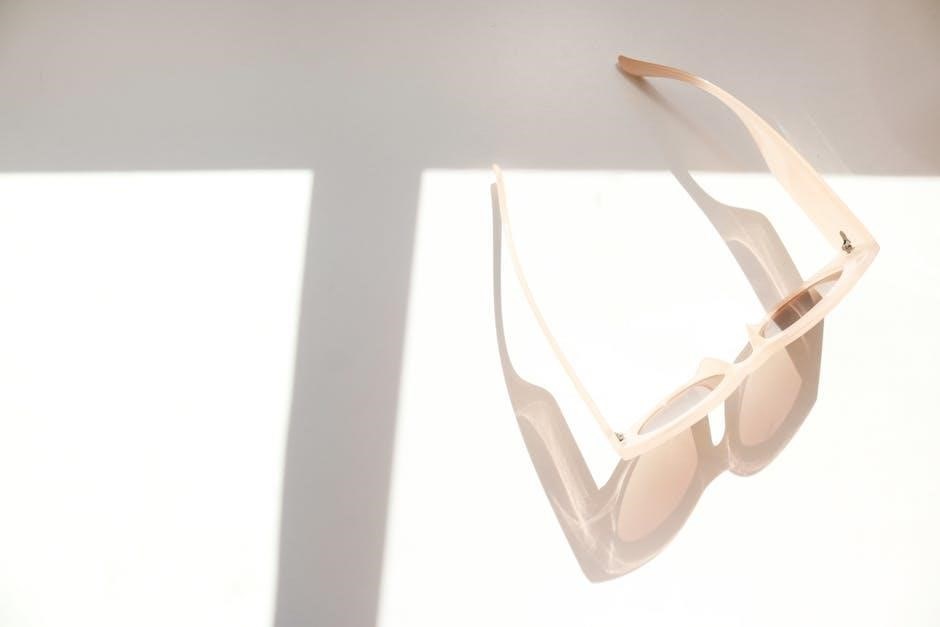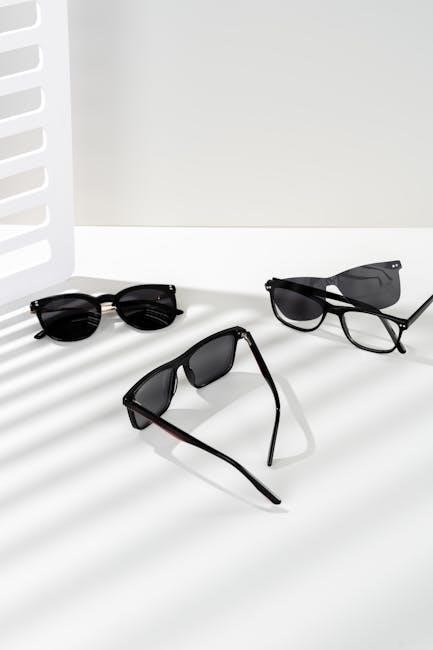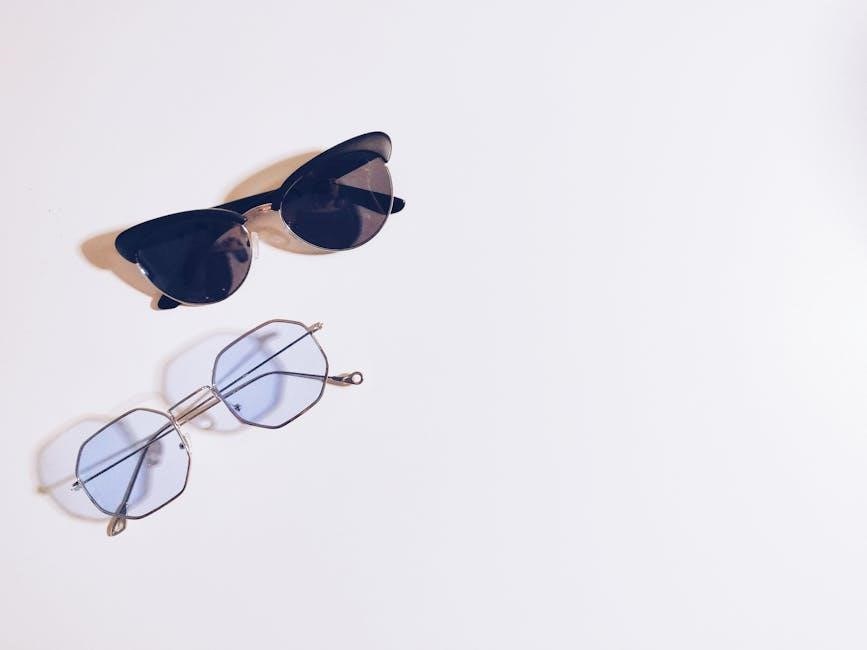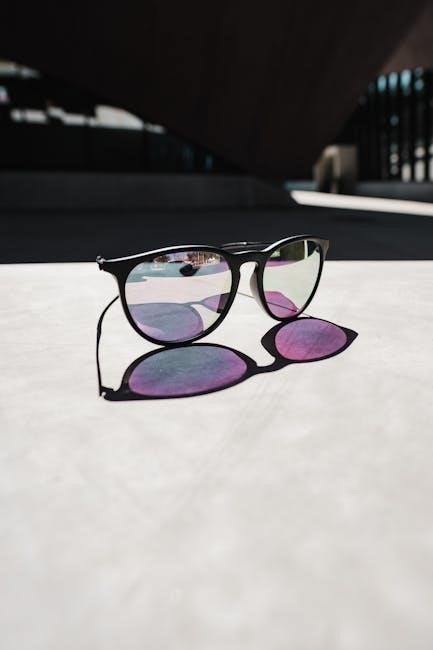Choosing the right sunglasses lens size ensures comfort, style, and proper UV protection. This guide helps you understand measurements, face shapes, and activities to find the perfect fit.
Why Lens Size Matters for Sunglasses
Proper lens size ensures optimal UV protection, comfort, and style. Oversized lenses provide better coverage, reducing sunlight exposure from the sides, while smaller lenses may leave eyes more vulnerable. Lens size also affects how frames fit your face shape—too large, and they may slip; too small, and they might feel tight. For sports or outdoor activities, larger lenses offer enhanced protection, while casual wear might prioritize versatility. Material and weight, such as polycarbonate or glass, can influence size preferences. Ultimately, the right lens size balances functionality and aesthetics, ensuring your sunglasses are both protective and stylish for any occasion.
- Optimal UV protection and eye comfort;
- Proper fit based on face shape and activity.
- Balance between functionality and style.
Key Measurements to Consider
When selecting sunglasses, several key measurements are essential to ensure the best fit and functionality. Lens width, measured in millimeters, determines coverage and style, with ranges typically between 40-60mm. Bridge width, the distance between the lenses, should match your nose shape for comfort. Temple length, measuring the arms of the sunglasses, affects how securely they stay in place. Lens height, though less common, impacts vertical coverage. Additionally, frame width and arm length are crucial for overall fit. These measurements ensure proper UV protection, comfort, and style, making them vital for choosing the right sunglasses for your needs and preferences.

- Lens width for coverage and style.
- Bridge width for nose fit.
- Temple length for stability.
- Frame width for overall fit.

Understanding Sunglasses Frame Measurements
Sunglasses frame measurements include lens width, bridge width, and temple length, ensuring a comfortable fit and proper coverage. Accurate sizing enhances both functionality and style.
- Lens width for eye coverage.
- Bridge width for nose fit.
- Temple length for stability.
Lens Width: How to Measure and Choose
Lens width is a critical measurement for sunglasses, directly impacting vision clarity and coverage. To measure, look for the horizontal distance across the lens in millimeters. For narrow faces, a 40-50mm width is ideal, while medium faces suit 50-54mm. Wide faces require larger lenses, typically 54mm or more. Consider face shape and activity: sports may demand oversized lenses for better protection. Ensure the width aligns with your face proportions to avoid overwhelming or under-covering your features. Proper lens width balances aesthetics, comfort, and functionality, ensuring optimal UV protection and visual acuity. Always check sizing charts or try frames to confirm the best fit for your needs.

Bridge Width: Importance and Measurement
Bridge width, measured in millimeters, is the distance between the two lenses, resting on the nose. Proper bridge width ensures comfort and stability. A narrow bridge (14-16mm) suits smaller faces, while medium (16-18mm) fits average faces, and wide bridges (18mm+) accommodate larger features. Measure by placing the frame on a flat surface and calculating the gap. Correct bridge width prevents tightness or slipping, crucial for long wear. It also affects the overall balance of the frame. Ensure the bridge complements your nose shape for a secure, comfortable fit. This measurement, combined with lens width, forms the frame’s front size, essential for selecting sunglasses that feel as good as they look.
Temple Length: Ensuring the Right Fit
Temple length, measured in millimeters, refers to the arms of the sunglasses that rest behind the ears. Proper temple length is crucial for a secure, comfortable fit. Most adult frames range between 135mm and 150mm, with longer temples offering better stability. Incorrect temple length can cause frames to slip down or apply too much pressure, leading to discomfort. Measure temple length by aligning the arms with your ears and ensuring they wrap snugly without tightness. This ensures the sunglasses stay in place during activities. A well-fitted temple length enhances overall comfort and stability, making it a key factor in choosing the right sunglasses. Ensure the temples are proportional to your face size for the best fit and functionality.

Face Shape and Sunglasses Lens Size
Understanding your face shape—narrow, medium, or wide—helps determine the ideal lens size for a balanced and flattering look, ensuring optimal coverage and style;

Narrow Face: Ideal Lens Width Range
For individuals with narrow faces, the ideal lens width typically ranges between 40-50mm. This size ensures a balanced and proportional look, avoiding lenses that may appear overly large or small. A narrower lens complements the facial structure by creating harmony without overwhelming the features. It’s important to select a lens width that provides adequate UV protection while maintaining a stylish appearance. Frames with slightly wider temples or subtle details can enhance the overall fit and aesthetics for narrow faces, ensuring both comfort and fashion. Choosing the right lens size ensures that the sunglasses not only look great but also function well for everyday wear.
Medium Face: Balanced Lens Dimensions
Individuals with medium face shapes benefit from lens widths between 50-54mm. This range offers a balanced and proportional fit, ensuring the sunglasses complement the facial features without appearing too large or small. A medium lens width provides adequate UV protection while maintaining a stylish appearance. Frames with moderate temple lengths and bridge widths enhance comfort and aesthetics for medium faces. This size is versatile, suiting various frame styles, from casual to formal designs. The 50-54mm range strikes the perfect balance between functionality and fashion, making it ideal for everyday wear or special occasions. Proper fit ensures long-lasting comfort and optimal performance of the sunglasses.

Wide Face: Larger Lenses for Optimal Coverage
For individuals with wide face shapes, opting for sunglasses with larger lenses ensures optimal coverage and protection from UV rays. Lens widths of 54mm or larger are ideal, as they proportionally fit wider facial features. Oversized or wraparound styles are excellent choices, offering both functionality and a fashionable look. Larger lenses not only shield the eyes but also complement the broader facial structure, creating a balanced appearance. Frames with sturdy temples and a wider bridge further enhance comfort and stability. This size range is perfect for those seeking maximum protection while maintaining a stylish edge. Proper fit ensures the sunglasses stay in place, providing all-day comfort and protection for wide faces.
Lens Size by Activity or Use Case
Activity influences lens size, with casual wear favoring versatility, sports requiring oversized protection, and formal events demanding stylish functionality for optimal performance and aesthetic appeal.
Casual Wear: Versatile Lens Sizes
For casual wear, sunglasses should offer a perfect blend of style and comfort. A versatile lens size ensures they complement various face shapes without appearing overly bulky. Typically, a lens width between 40mm for narrow faces and 54mm for wider faces works well, providing adequate UV protection while maintaining a fashionable look. The key is to choose a size that isn’t too tight or too loose, ensuring all-day wearability. Casual sunglasses should be lightweight and comfortable, making them suitable for everyday use. Oval and round frames are popular for casual settings, as they pair well with most outfits. Additionally, frames with soft rubber grips can enhance comfort, and mirrored lenses can add a trendy touch. By selecting the right lens size, you can enjoy both functionality and aesthetics, whether you’re running errands or lounging outdoors.
Sports and Outdoor: Oversized Lenses for Protection
For sports and outdoor activities, oversized sunglasses lenses are ideal for maximum protection. They provide enhanced coverage, reducing peripheral light and debris exposure. Wraparound frames are popular, offering a secure fit during high-intensity movements. Lens widths typically range from 55mm to 65mm, ensuring comprehensive UV protection; Polycarbonate or Trivex lenses are recommended for their impact resistance, making them durable for rugged environments. Rubber grips on temples and nose pads improve stability, preventing slippage during activities like cycling or hiking; Oversized lenses also reduce glare from water or snow, making them perfect for fishing or skiing. Prioritizing functionality, these sunglasses combine style with practicality, ensuring safety and comfort in demanding conditions.
Formal Events: Stylish yet Functional Lens Sizes
For formal events, sunglasses should strike a balance between style and functionality. Lens sizes typically range from 50mm to 58mm, offering a sleek, elegant look while providing adequate coverage. Oval or round frames are popular choices, complementing most face shapes. Polarized lenses are ideal for reducing glare, ensuring clarity and comfort. While oversized lenses are practical for sports, slightly smaller lenses are more suited for formal occasions, maintaining sophistication without compromising protection. Comfort is key, so ensure the frame fits securely without feeling too tight. UV protection remains essential, even in stylish designs. This blend of aesthetics and functionality makes formal sunglasses a versatile accessory for any refined setting.

Additional Factors Influencing Lens Size
Comfort, lens material, and UV protection are crucial. Lighter materials reduce weight, while proper UV coverage ensures eye safety without compromising style or fit.
Comfort and Fit: Avoiding Too Tight or Too Loose
Ensuring your sunglasses fit comfortably is essential for long-term wear. Frames that are too tight can cause discomfort, while those too loose may slip or move. Proper temple length and bridge width measurements help maintain balance. Lighter lens materials reduce pressure, enhancing comfort without sacrificing style. Avoid frames that dig into your temples or leave gaps around your nose; Adjustable nose pads can provide a secure fit for various face shapes. Testing frames in person or using virtual try-on tools can help determine the ideal fit. Remember, sunglasses should stay in place without feeling restrictive, offering both protection and ease throughout the day.

Lens Material: How It Affects Size and Weight
The material of your sunglasses lenses significantly impacts both size and weight. Lightweight materials like polycarbonate and Trivex are ideal for larger lenses, as they reduce overall weight without compromising durability. Glass lenses, while offering superior optical clarity, are heavier and thicker, making them less suitable for oversized frames. Acrylic lenses are budget-friendly and lightweight but may lack the impact resistance of other materials. Thinner, high-index lenses are perfect for stronger prescriptions, minimizing bulk while maintaining clarity. The choice of lens material should align with your lifestyle and needs, balancing comfort, protection, and aesthetic preferences. Proper material selection ensures your sunglasses are both functional and comfortable for extended wear.
UV Protection: Ensuring Adequate Coverage
UV protection is a critical factor in choosing sunglasses, as it directly impacts eye health. Larger lenses provide greater coverage, reducing exposure to harmful UV rays. However, lens size must balance protection with comfort and face shape. Materials like polycarbonate and glass inherently block UV light, while others may require UV-coating. Opt for lenses that block 99-100% of UV rays (UV 400 protection) for maximum safety. Oversized or wraparound styles offer enhanced coverage, especially for outdoor activities. Ensure your sunglasses meet UV protection standards, regardless of lens size, to safeguard your eyes from long-term damage. Proper fit and adequate coverage are essential for both functionality and eye health.